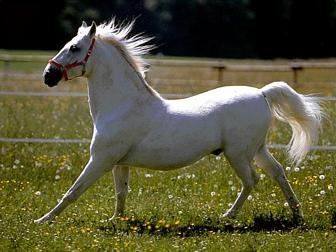
OVERVIEW
The Lipizzaner's name was derived from the location in which it was first bred in 1580, the Imperial Stud at Lipizza, near Trieste. The Lipizzaner is the horse of preference for the famous Spanish Riding School of Austria. Only superlative stallions which are light gray to white in color are considered for training, which they begin at the age of five. Those stallions which demonstrate excellence at the school are eventually retired to stud at Piber, the government farm were modern Lipizzaners are bred. Those individuals not suitable for the school often become excellent hunters, three-day-event horses or driving horses. The Lipizzaner's ancestors include the Arabian, Neapolitan, Barb, Andalusian and Kladruber.
PHYSICAL DESCRIPTION
The Lipizzaner is not a very large horse, averaging between 14.2 and 15.2 hands, although occasionally reaching 16 hands. It has a relatively large head with small ears, dark, expressive eyes and often a convex nose which is reminiscent of its Spanish ancestry. The body is compact with smooth musculature and substantial shoulder. The legs are short and clean, with small, hard hooves. The most common color is white (gray); although foals are born black, they turn gray with maturity. Chestnut, bay and roan are also found. The Lipizzaner is known for its docile temperament and intelligence. Longevity is a common characteristic since the breed matures late.
ORIGIN
The Lipizzaner is descended from horses from various parts of Europe. The foundation stallions were: Maestoso and Favory (Kladrubers), Conversano and Neapolitano (from Italy, but Spanish); Pluto ( Danish Fredericksborg) and Siglavy (Arabian).
INTERESTING FACTS
Lipizzaners were originally bred at the Stud at Lipizza by Rudolf II, beginning in 1580 , and later at Piber, Austria. The horses from Lipizza were used at the Spanish Riding School after its founding in 1738. They are now bred in the Czech Republic, Hungary, Austria and the United States.
INFLUENCES
1. Arabian
2. Barb
3. Andalusian
4. Neapolitan
5. Kladruber
6. Fredericksborg
For more information:
Lipizzan Association of North America
Listed as "Rare" by The American Livestock Breeds Conservancy (2004)